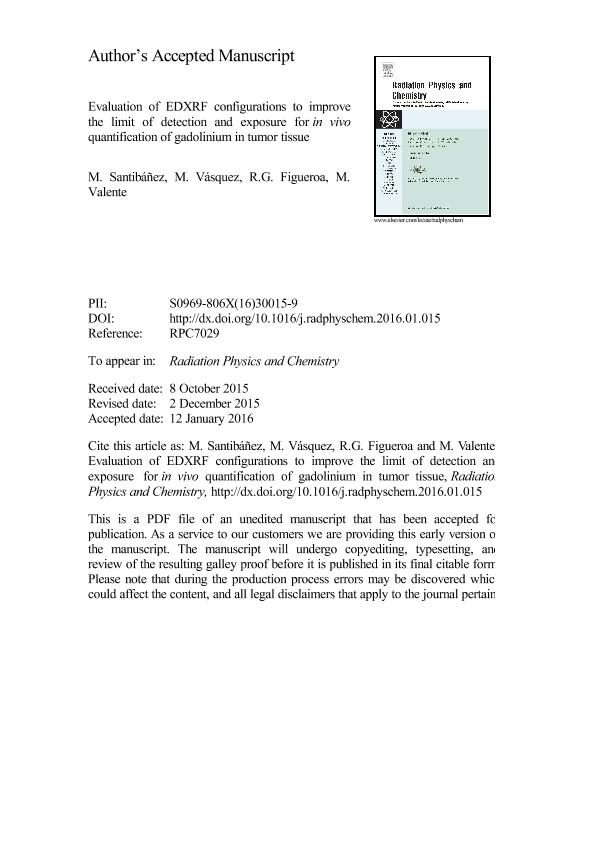Mostrar el registro sencillo del ítem
dc.contributor.author
Santibáñez, M.
dc.contributor.author
Vásquez, M.
dc.contributor.author
Figueroa, R. G.
dc.contributor.author
Valente, Mauro Andres

dc.date.available
2019-03-13T20:32:54Z
dc.date.issued
2016-05
dc.identifier.citation
Santibáñez, M.; Vásquez, M.; Figueroa, R. G.; Valente, Mauro Andres; Evaluation of EDXRF configurations to improve the limit of detection and exposure for in vivo quantification of gadolinium in tumor tissue; Pergamon-Elsevier Science Ltd; Radiation Physics and Chemistry (Oxford); 122; 5-2016; 28-34
dc.identifier.issn
0969-806X
dc.identifier.uri
http://hdl.handle.net/11336/71548
dc.description.abstract
In this paper the configuration of an Energy Dispersive X-Ray Fluorescence (EDXRF) system optimized for in vivo quantification of gadolinium in tumor tissue was studied. The system was configured using XMI-MSIM software designed to predict the XRF spectral response using Monte Carlo simulations. The studied setup is comprised of an X-ray tube, tuned to different voltages, and a copper filter system configured with variable thickness, which emits a spectrally narrow beam centered on the specific excitation energy. The values for the central energy excitation and the spectral width were adjusted to optimize the system, using like figures of merit: minimization of the limit of detection, measurement uncertainty and radiation exposure. These values were obtained in two stages. The first was successive simulations of incident spectra with central energy in the range of 50-70keV. The second was comprised of simulations with incident spectra of different widths (8-29keV), all with the same determined central energy, evaluating the limit of detection depending on the exposure. This made it possible to find the best balance between system sensitivity and the delivered dose. The obtained results were compared with those produced by radioactive sources of 241Am whose activity was set to produce the same exposure as the proposed setup. To evaluate the feasibility of in vivo quantification, a set of tumor phantoms of 1-6cm3 at different depths and labeled with a gadolinium concentration of 250ppm was evaluated. From the resulting spectrum, calibration curves were obtained in function of the size and depth of the tumor, allowing for the evaluation of the potential of the methodology.
dc.format
application/pdf
dc.language.iso
eng
dc.publisher
Pergamon-Elsevier Science Ltd

dc.rights
info:eu-repo/semantics/openAccess
dc.rights.uri
https://creativecommons.org/licenses/by-nc-nd/2.5/ar/
dc.subject
Gadolinium
dc.subject
In Vivo Edxrf
dc.subject
Xmi-Msim
dc.subject.classification
Otras Ciencias Físicas

dc.subject.classification
Ciencias Físicas

dc.subject.classification
CIENCIAS NATURALES Y EXACTAS

dc.title
Evaluation of EDXRF configurations to improve the limit of detection and exposure for in vivo quantification of gadolinium in tumor tissue
dc.type
info:eu-repo/semantics/article
dc.type
info:ar-repo/semantics/artículo
dc.type
info:eu-repo/semantics/publishedVersion
dc.date.updated
2019-03-13T17:37:59Z
dc.journal.volume
122
dc.journal.pagination
28-34
dc.journal.pais
Estados Unidos

dc.description.fil
Fil: Santibáñez, M.. Universidad de La Frontera; Chile
dc.description.fil
Fil: Vásquez, M.. Universidad de La Frontera; Chile
dc.description.fil
Fil: Figueroa, R. G.. Universidad de La Frontera; Chile
dc.description.fil
Fil: Valente, Mauro Andres. Universidad de La Frontera; Chile. Universidad Nacional de Córdoba. Facultad de Matemática, Astronomía y Física; Argentina. Consejo Nacional de Investigaciones Científicas y Técnicas. Centro Científico Tecnológico Conicet - Córdoba. Instituto de Física Enrique Gaviola. Universidad Nacional de Córdoba. Instituto de Física Enrique Gaviola; Argentina
dc.journal.title
Radiation Physics and Chemistry (Oxford)

dc.relation.alternativeid
info:eu-repo/semantics/altIdentifier/doi/http://dx.doi.org/10.1016/j.radphyschem.2016.01.015
dc.relation.alternativeid
info:eu-repo/semantics/altIdentifier/url/https://www.sciencedirect.com/science/article/pii/S0969806X16300159
Archivos asociados
